This document provides an overview of a capstone project that created a pilot program for remedial algebra teachers. The pilot program aimed to test motivational materials and student grouping to improve student motivation. Four classes were assigned different conditions: traditional material with no grouping (control), traditional material with grouping, motivational material with no grouping, and motivational material with grouping. Data on motivation and academics was collected from questionnaires, tests, and notes for the four classes and compared. The goal was to see if motivation increased with the added variables. Resources for the pilot included lesson plans, presentations, packets, and scales. An expert panel provided feedback and the creator conducted a self-assessment. The discussion reflected on addressing core outcomes related to instruction
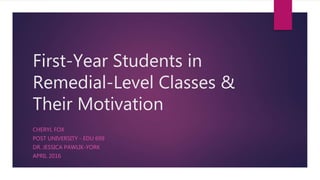
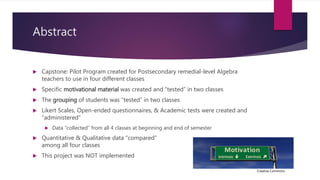



![Literature Review – Motivation &
Academic Success
Motivation:
Definition: processes underlying initiation, control,
maintenance & evaluation of goal-oriented
behaviors (Goetz & Hall, 2013, p. 59)
Current state of one’s motivation to pursue a
course of action depends on individual’s
characteristics and specific situation
Each student will have different motivational
state since each will possess different
characteristics
Who is responsible for motivation in the
classroom?
Teachers can plant the seeds
Students take over and become autonomous and
self-sufficient!
Correlation between high degree of motivation
and greater degree of educational success (Moore,
2007)
Teachers should focus on intrinsic motivation
(Finlay, 2010)
Teachers can provide alternative learning
pathways
Intrinsic motivation is correlated with andragogy
Moore, R. (2007). Academic motivation and performance of developmental education biology students. Journal of Developmental Education, 31(1), 24-34.
Goetz, T., & Hall, N. C. (2013). Emotion, Motivation, and Self-regulation: A Handbook for Teachers. Retrieved from http://eds.b.ebscohost.com/eds/ebookviewer/ebook/bmxlYmtfXzUyNTU4OF9fQU41?sid=62dbf551-8cbf-41d5-af47-
f4e109d172c1@sessionmgr112&vid=0&format=EB&rid=1
Finlay, J. (2010, May). Andragogy (Adult Learning) [Video File]. Retrieved from https://www.youtube.com/watch?v=vLoPiHUZbEw
commons.Wikimedia.org/ Creative
Commons
rappingmanual.com/ Creative
Commons](https://image.slidesharecdn.com/69434d57-2c2f-4e31-92df-0f6358471876-160430080457/85/PRESENTATION-6-320.jpg)

![Literature Review – Challenging
Conditions & Motivation
Learning happens when students interact with their environment
Students must be presented with tasks just outside of their current abilities in the Zone of Proximal
Development (ZPD) in order to learn {posited by Lev Zygotsky} (Bcb704, 2012)
Instructors should assign tasks in the ZPD
Students learn material with help from instructor
Students move on to master new material
Students become intrinsically motivated
Accomplished something
Learned something they did not know before
Goal: get students themselves to choose challenges with difficulty levels that ensure optimal learning
Challenges – Not too easy/not too hard
Lead to self-sufficiency & engagement
Bcb704. (2012, April 4). Vygotsky’s zone of proximal development [Video file]. Retrieved from https://www.youtube.com/watch?v=0BX2ynEqLL4
Zygotsky’s Zone of Proximal Development.
blog.matbury.com/ Creative Commons](https://image.slidesharecdn.com/69434d57-2c2f-4e31-92df-0f6358471876-160430080457/85/PRESENTATION-8-320.jpg)


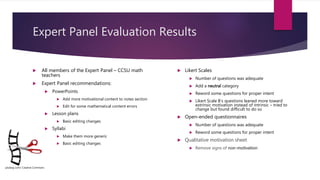












![Discussion & Reflection
Higher Education Administration Outcomes addressed:
3. Students will identify, analyze and evaluate change leadership
strategies in the administration of higher education
a. Capstone could be piloted in many different places to collect as
much data as possible
i. Convincing people that using the Pilot is beneficial can only happen
with the data to back it up
b. Lewin’s Change Model – 3 steps in the process of change in
organization: (Hartzell, 2014)
i. Unfreezing – create an awareness of how the current level of
acceptability of something within the organization is hindering that
organization in some way
a. Clearly, students having to repeat Math 099 or leave CSU
system to take class is not ideal situation
ii. Changing – how can the conditions be changed?
a. Use the Pilot to help students become motivated
so they will not have to repeat the class a number of
times/drop out of CSU system
iii. Refreezing – setting the new plans in place and
making sure everyone involved sticks to new plans
c. Make sure to get employees to realize that the
change happening is not random but rather for some
ultimate end/condition for which is desired (Elliott &
Paton, 2014)
i. Employees are more likely to get on board
d. Allow teachers to add their own input to a
changing situation
i. Teachers can add to syllabi, or even add their own
resources
Hartzell, S. (2014, April). Lewin Stage Model of Change Unfreezing Change Refreezing Animated Part 5 [Video File]. Retrieved from https://www.youtube.com/watch?v=kerDFvln7hU
Elliott, R. W., & Paton, V. O. (2014). An effective leader in higher education: Charles William Eliot. Journal of International Education and Leadership, 4. Retrieved from http://www.jielusa.org/wp-content/uploads/2012/01/CharlesWilliamEliot.pdf](https://image.slidesharecdn.com/69434d57-2c2f-4e31-92df-0f6358471876-160430080457/85/PRESENTATION-24-320.jpg)
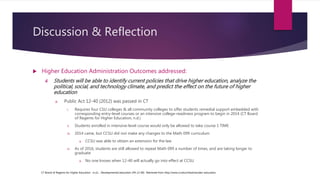
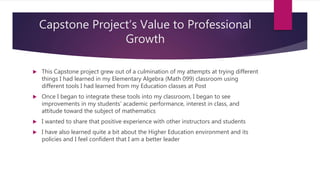



![References
Bcb704. (2012, April 4). Vygotsky’s zone of proximal development [Video file]. Retrieved from
https://www.youtube.com/watch?v=0BX2ynEqLL4
Bettinger, E. P., Boatman, A., & Long, B. T. (2013). Student supports: Developmental education and other
academic programs. Future of Children, 93-115.
Cook, J. (2015). Increasing number of high school graduates taking remedial math, english. Retrieved
from http://www.dothaneagle.com/news/education/increasing-number-of-high-school-graduates-taking-
remedial-math-english/article_7910ad34-c129-11e4-9b30-4bb2799b26d5.html
CT Board of Regents for Higher Education. (n.d.). Developmental education (PA 12-40). Retrieved from
http://www.ct.edu/initiatives/dev-education
Elliott, R. W., & Paton, V. O. (2014). An effective leader in higher education: Charles William Eliot. Journal
of International Education and Leadership, 4. Retrieved from http://www.jielusa.org/wp-
content/uploads/2012/01/CharlesWilliamEliot.pdf
Finlay, J. (2010, May). Andragogy (Adult Learning) [Video File]. Retrieved from
https://www.youtube.com/watch?v=vLoPiHUZbEw](https://image.slidesharecdn.com/69434d57-2c2f-4e31-92df-0f6358471876-160430080457/85/PRESENTATION-30-320.jpg)
![References
Goetz, T., & Hall, N. C. (2013). Emotion, Motivation, and Self-regulation: A
Handbook for Teachers. Retrieved from
http://eds.b.ebscohost.com/eds/ebookviewer/ebook/bmxlYmtfXzUyNTU4OF9fQU
41?sid=62dbf551-8cbf-41d5-af47-
f4e109d172c1@sessionmgr112&vid=0&format=EB&rid=1
Hartzell, S. (2014, April). Lewin Stage Model of Change Unfreezing Change
Refreezing Animated Part 5 [Video File]. Retrieved from
https://www.youtube.com/watch?v=kerDFvln7hU
Merriam, S., Caffarella, R., & Baumgartner, L. (2007). Learning in adulthood: A
comprehensive guide. San Francisco: Jossey-Bass.
Moore, R. (2007). Academic motivation and performance of developmental
education biology students. Journal of Developmental Education, 31(1), 24-34.](https://image.slidesharecdn.com/69434d57-2c2f-4e31-92df-0f6358471876-160430080457/85/PRESENTATION-31-320.jpg)